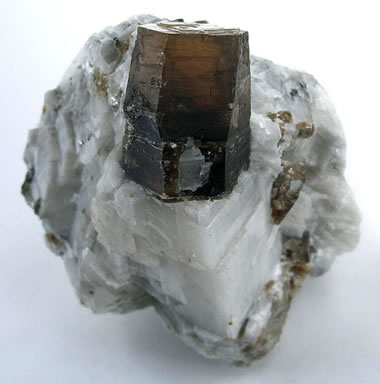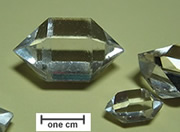Phlogopite
Called "brown mica" after its color, "magnesia mica" after its composition.
Article by: Hobart M. King, PhD, RPG

Phlogopite: A partial crystal of phlogopite and a few cleavage flakes. The stepped sides of the crystal reveal its many cleavage planes. When a phlogopite crystal is separated into thin cleavage flakes, the flakes are colorless, flexible, and elastic. This specimen measures approximately 24 x 14 x 6 millimeters in size.
What Is Phlogopite?
Phlogopite is a common member of the mica mineral group. It has a chemical composition of KMg3(AlSi3O10)(F,OH)2. Crystals of phlogopite are often brown, but can be yellow, green or reddish brown. It is sometimes called "the brown mica".
When a phlogopite crystal is split into very thin sheets, the sheets are transparent, lustrous, chemically inert, tough, elastic, flexible, and insulating. These and other properties of phlogopite enable it to be used to manufacture a variety of products. Phlogopite and muscovite are the only two mica minerals that are used commercially.
Table of Contents
 What Is Phlogopite? What Is Phlogopite? Geologic Occurrence Geologic Occurrence Physical Properties of Phlogopite Physical Properties of Phlogopite Uses of Phlogopite Uses of Phlogopite The Other "Fool's Gold" The Other "Fool's Gold" |

Barrel-Shaped Phlogopite Crystal and small phlogopite flakes in white marble. Cleavage steps can be seen on the top of the crystal. This specimen was collected from Franklin, New Jersey and measures 8.6 x 7.1 x 6.4 centimeters in size. Specimen and photo by Arkenstone / www.iRocks.com.
Geologic Occurrence
Phlogopite is usually found in metamorphic rocks. An ideal condition for phlogopite formation is when a dolomitic limestone or a magnesium-rich limestone, with some clay content, is subjected to hydrothermal metamorphism.
The result is typically one of the following: (A) scattered flakes and small crystals of phlogopite throughout the rock; (B) concentrations of phlogopite in parts of the limestone where clay was abundant; or, (C) concentrations of phlogopite in metamorphosed shale along the margins of the limestone. Phlogopite schist can form through this same process.
Phlogopite is also found in igneous rocks. These include ultramafic rocks such as peridotite, kimberlite, lamproite, and serpentinite. Phlogopite is also found in high-alumina basalts. Almost all sheet and block mica is found in pegmatites.
Physical Properties of Phlogopite |
|
| Chemical Classification | Silicate, phyllosilicate |
| Color | Usually yellowish, yellowish brown, brown, reddish brown. Rarely green, colorless or almost black. |
| Streak | White, often sheds tiny flakes. |
| Luster | Pearly to vitreous. Reflections from cleavage faces can appear silver, gold or copper metallic. |
| Diaphaneity | Transparent to translucent in small pieces. Large pieces appear opaque until a small piece is cleaved off. |
| Cleavage | Perfect |
| Mohs Hardness | 2 to 2.5 |
| Specific Gravity | 2.75 to 2.9 |
| Diagnostic Properties | Color, cleavage, transparency, luster. |
| Chemical Composition | KMg3(AlSi3O10)(F,OH)2 |
| Crystal System | Monoclinic |
| Uses | Compared to muscovite, phlogopite has fewer industrial uses because of its color and is not used when the color of the particles are important. Used in manufacturing plastics, rubber, asphalt roofing, drilling mud. |
Physical Properties of Phlogopite
Phlogopite has a few physical properties that can help you identify it. The first is a yellow to brown to reddish brown color. Next, as a mica, phlogopite easily splits into thin sheets that are transparent, flexible, elastic, and tough.
Phlogopite crystals can be tabular with a pseudohexagonal shape, or they can be barrel-shaped prisms with a pseudohexagonal cross-section. Although phlogopite is a monoclinic mineral, the c-axis is so gently inclined that it would be easy to think that phlogopite is hexagonal.
Phlogopite has many properties that make it valuable in manufacturing. It can be cleaved into thin sheets that can serve as electronics boards. These are stiff but flexible, and they can easily be cut to shape, punched, or drilled. Phlogopite is heat resistant, does not transmit electricity, and is a poor conductor of heat.
Uses of Phlogopite
Phlogopite and muscovite are the only two mica minerals that are used commercially. Phlogopite is used less often than muscovite because it is less available and because its brown color is undesirable for some uses. Much phlogopite is used in plastic composite body parts for automobiles. Phlogopite increases the stiffness of the plastic, provides greater dimensional stability, and reduces distortion upon temperature change.
Ground phlogopite is used as a substitute for asbestos in automobile brake linings and clutch plates. It is added to industrial coatings used to increase strength, increase stiffness, and to improve resistance to heat, chemicals and ultraviolet rays. It is an additive that increases the strength of epoxies, nylons, and polyesters.
Sheet mica is used in the electronics industry to make stiff, heat-resistant, non-conducting boards for electronic components. Sheet mica boards can be cut, punched, stamped, and machined to close tolerances. Sheet mica is the most valuable mica product because each piece must be recovered by hand. Top-quality phlogopite sheet mica was selling for over $2,000 per kilogram in 2017. [1]
| Phlogopite Information |
|
[1] Mica by Kenneth C. Curry, 2017 Minerals Yearbook, an annual publication by the United States Geological Survey, 8 pages, published February 2020.
|
The Other "Fool's Gold"
Tiny flakes of phlogopite and biotite have been known to excite beginning gold panners. In many areas, tiny flakes of these micas are abundant in streams where gold can be panned.
When a flake of phlogopite catches the sun, it can reflect a bright flash of bronze-colored light. When this flash catches the eye of an inexperienced prospector, they can immediately think they have found gold.
If the panner is prepared, they will remove one of these flakes from the pan and poke it with a pin. If the flake breaks, it is mica (or some other deceptive grain). However, if it bends around the pin, then it is either gold or another soft material. First-time panners quickly learn to do some testing before shouting "gold" at the top of their lungs - which is a terrible idea anyway because it will call in unwanted visitors from miles around.
| More Minerals |
 |
Herkimer Diamonds |
 |
The Acid Test |
 |
Tumbled Stones |
 |
Zircon |
 |
Fool*s Gold |
 |
Kyanite |
 |
Rock Tumblers |
 |
Rhodochrosite |

Find Other Topics on Geology.com:

|

| ||

|

| ||

|

| ||

|

|
